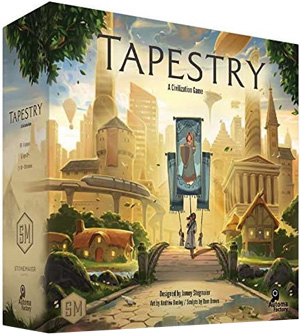



play board games
Board game reviews, strategy tips & session reports
Tapestry Board Game Review
 Stats:
Stats:
No. of players: 1-5
Amount of time to play: 90-120 min
Age requirements: 12+
Set-up time: 5 min
Tapestry is a civ-themed, engine-building board game with multiple paths to victory. Your task is finding the most efficient way to score enough VPs to win.
Tapestry Rules Description:
You start Tapestry with two civilizations one of which you keep. There are sixteen civilizations in the game and each one grants you unique abilities. You also have a player board and capital city mat.
The board has a map in the center and four different advancement tracks around the outside edge of the board. The four tracks on the board represent Exploration, Science, Technology, and Military.
The game takes place over five eras. Each era begins with an Income phase during which you activate your civilization (if applicable), gain resources, and upgrade one technology card. Also after the first era you play one tapestry card. These cards give you a one-time bonus or a bonus that lasts for that era.
On your turn you either advance on one of the four tracks on the board or move onto your next era (beginning with Income). To advance on any of the advancement tracks, you must be able to pay the resources needed. Then you get the benefit from that space. These benefits include more resources, adding buildings to your capital city mat, gaining a technology or tapestry card or expanding your presence on the central map.
Buildings come off your player board and reveal additional resources and points you’ll gain during the Income phase. If you reach specific spaces on the advancement tracks first, you get a larger building to add to your capital city mat. This mat is divided into a three by three grid that is subdivided into a three by three grid. When you fill one of the larger grids you instantly gain a resource of your choice. You score your capital city during the Income phase and get a VP for each row or column you have filled.
If you are unable (or don’t want) to move up an advancement track due to lack of resources, you must enter the next era. This means not all players will be in the same era all the time. Some players will finish the game while others continue to have resources to spend and advance. The game ends once all players have advanced to the fifth and final era. It consists of a final Income phase but you won’t play a tapestry card or gain resources. The player with the most VPs wins.
Quick Review of Tapestry:
Tapestry is a simple game mechanically but it has a lot going on and lots of ways to score. You need to determine the most efficient way to score VPs and make use of your civilization and tapestry cards. It will take a few plays to grasp the different ways to maximize your scoring opportunities.
The components for this game are pretty amazing. The unique buildings look great but I wish they were easier to tell apart and fit on the grid on the capital city mat more exactly. Those quibbles aside, the game looks impressive on the table. The rules are not very long, but give enough details to get you playing quickly. Be aware some rules are only on the reference sheets and you might need to search the internet for some clarifications, but most rulings are intuitive. Watch It Played made an excellent tutorial video which I recommend.
Tapestry is one of those games that’s easy to teach but will take a few games to fully grasp its possibilities. It is not a gateway game, but if you have played some other Eurogames, this game a great next step.
This game plays similarly at different player counts. The turns are quick and you can usually plan ahead. So downtime is minimal.
The asymmetrical civilizations and tapestry cards create a bunch of combinations to try out. The replayability of this board game is through the roof. And though the civilizations were deemed to be unbalanced newer printings of the game have made adjustments to them. Or you can download the updates here.
Tapestry feels like a puzzle you need to solve that has many different answers. And some answers are better than others. You want to figure out the best answer to the puzzle you are dealt. You start with meager resources and must build an engine that can churn out lots of VPs. When you do that well it is a thrilling experience.
But not everything is thrilling about the experience. Since eras end at different times, players finish at different times. Finishing first means waiting for others to finish. It also usually means you’ve lost. This can be ten minutes or thirty. Watching someone in lead continue to take turns and gain even more VPs isn’t very fun.
That leads to my other issue with the game. In our plays we almost always had a runaway leader. Halfway through the game (or so) we generally knew who was going to win. This might go away if everyone at the table has played several times. But we had different players with multiple plays in the lead for a lot of the game.
Tapestry is an engine building games with lots of combinations to explore. Maximizing your scoring is key and what is most enjoyable about the game. It is not perfect but it is definitely worth trying out. If you are a fan of engine-building board games, pick this one up!
Score and synopsis: (Click here for an explanation of these review categories.)
Strategy 4 out of 6
Luck 5 out of 6
Player Interaction 3 out of 6
Replay Value 6 out of 6
Complexity 4 out of 6
Fun 4 out of 6
Overall 4 out of 6

Leave a Reply